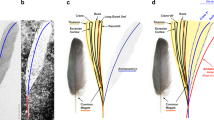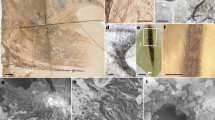Abstract
The elongated dorsal appendages of the reptile Longisquama insignis , from the Triassic of Kyrgyzstan1, have recently been reinterpreted as the first record of feathers in a non-avian tetrapod2 — long predating the feathers of the oldest known bird, Archaeopteryx. Here we present evidence that the dorsal scales of Longisquama are not feathers, and that they are in fact strikingly different from avian feathers. We conclude that Archaeopteryx remains the oldest known feathered tetrapod.
Similar content being viewed by others
Main
Longisquama is a small diapsid reptile with an uncertain phylogenetic position. It is known from an incomplete skeleton with integumentary appendages and isolated appendages. Appendage PIN (for Palaeontological Institute of the Russian Academy of Sciences) 2584/7, preserved as part and counterpart, retains an infilling of fine-grained sediment and high-fidelity impressions of the external left and right surfaces of the appendage ( Fig. 1). This infilling, preserved either on one side of the specimen or on the counterpart, shows that the tubular configuration described for the proximal portion extends along the entire length of the appendage, although the distal portion is expanded anteroposteriorly and flattened transversely. This indicates that in life the two external surfaces were separated from each other by an intervening space (now sediment-filled).
Where the sedimentary infilling (black circles) is not preserved, sharp impressions of the corrugated external surface of the structure are visible (white circles). Arrows point to corresponding patches of sedimentary infilling on part and counterpart. ab, anterior smooth band; c, corrugations; v, median 'vein'.
There are no feather-like features on the distal portion of the appendage. Here, two corrugated membrane-like surfaces touch along their leading and trailing edges to form wide, smooth bands. The two membranes were apparently supported by a median vein-like structure extending the length of the appendage. This has been proposed as the homologue of the rhachis of avian feathers2. On either side of this 'vein', the external surfaces of the appendage are corrugated. This corrugation varies along the appendage: proximally, individual rugae are relatively large and widely spaced, but in the distal portion they are smaller and densely packed. The densely arranged distal corrugations have been compared to the pinnae of avian feathers2, but the fossils indicate that these are formed on a membrane-like structure on either side of the 'vein'.
The fossils were split into part and counterpart during collecting, and most of the appendages are now preserved as impressions of their left and right sides, without the intervening sediment core. The surfaces of both the part and counterpart impressions of individual appendages are concave, an indication that these structures are three-dimensional. In contrast, the parts and counterparts of feather impressions in Archaeopteryx are concave and convex, respectively.
We believe that the dorsal appendages of Longisquama are highly modified scales, as suggested previously1,3, rather than feathers. Examination of the holotype of L. insignis (PIN 2584/4) suggests that they were anchored in the skin or epaxial muscles.
References
Sharov, A. G. Paleontol. Zhur. 1970, 127–130 (1970).
Jones, T. et al. Science 288, 2202–2205 (2000).
Feduccia, A. The Origin and Evolution of Birds (Yale Univ. Press, New Haven, 1996).
Author information
Authors and Affiliations
Corresponding author
Rights and permissions
About this article
Cite this article
Reisz, R., Sues, HD. The 'feathers' of Longisquama. Nature 408, 428 (2000). https://doi.org/10.1038/35044204
Issue Date:
DOI: https://doi.org/10.1038/35044204
This article is cited by
-
The dorsal appendages of the Triassic reptile Longisquama insignis: reconsideration of a controversial integument type
Paläontologische Zeitschrift (2012)
-
An Early Cretaceous heterodontosaurid dinosaur with filamentous integumentary structures
Nature (2009)
-
Feather-like development of Triassic diapsid skin appendages
Naturwissenschaften (2009)
Comments
By submitting a comment you agree to abide by our Terms and Community Guidelines. If you find something abusive or that does not comply with our terms or guidelines please flag it as inappropriate.




